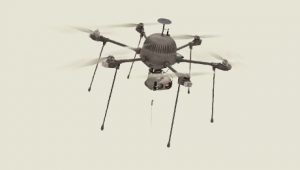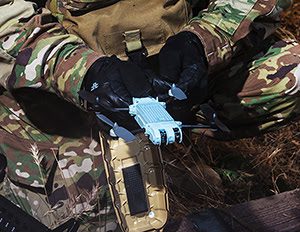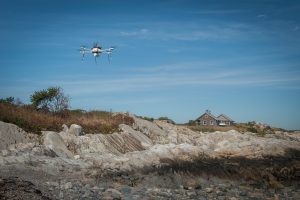The drone trade continues to be within the early levels of progress, nevertheless it appears to have progressed previous the very first section of bleeding edge expertise and to be transferring – quickly – in direction of confirmed answer. As enterprises ramp up adoption of drone expertise, drone producers who began promoting within the navy area are transferring to fulfill them.
The shift isn’t as large because it might sound. Steve Gitlin, VP Corporate Strategy, Communications and Investor Relations at AeroVironment says that they haven’t been serving navy prospects – they been serving innovators. “We consider ourselves a technology company,” says Gitlin. “When we first developed the hand launched UAV for reconnaissance in 1986, we knew that this could be used across a broad range of industries. We also knew that the government would be the most likely early adopter.”
“We’ve been serving the innovators in the industry,” he says. “They’re the customers who have formed that value chain that allow us to bring the technology to the commercial market as regulations allow.”
It’s a theme that rings true for a lot of the corporations increasing from the navy into the enterprise. While the industrial market could make the most of applied sciences another way, the core applied sciences usually translate effectively. And enterprise prospects, averse to threat on the subject of large expertise investments, like having their options examined by a number of the most demanding prospects on this planet.
Here are 3 drone applied sciences first adopted by the navy displaying up on civil worksites across the globe.
 Eyes within the Sky: Tethered Drones
Eyes within the Sky: Tethered Drones
MA-based CyPhy Works is the main supplier of tethered drone expertise. The Persistent Aerial Reconnaissance and Communications platform – PARC™ – is a drone climate and wind resistant drone utilizing CyPhy’s patented microfilament tethered system to supply safe communication and energy – translating to flight endurance of days reasonably than minutes. The tether – which the corporate describes as “thin as a headphone cord” can maintain PARC anchored to at least one location, making it a super answer for a lot of varieties of surveillance.
CyPhy Works founder and CTO Helen Greiner says that the tether simply is sensible for a lot of purposes. “It’s a surprisingly efficient and effective solution for keeping a drone in one place,” says Greiner. “We see growth in traffic management, oil and gas, asset management, hazardous incident response… anywhere you might need an eye in the sky.”
That “eye in the sky” is a strong instrument. High powered optical permits prospects to zoom in on no matter is happening on the bottom, making the system fascinating for a lot of varieties of public security and safety occasions along with industrial makes use of. The humanitarian makes use of for the drone are legion additionally – the PARC is moveable and rugged sufficient to supply catastrophe response intelligence, or to determine a communications community in a specified space after a catastrophe.
 Inaccessible Spaces: Tiny Drones
Inaccessible Spaces: Tiny Drones
AeroVironment covers many features of the industrial market, together with precision agriculture, vitality and infrastructure. But one of many merchandise they’ve bought for years into the navy sector gives uncommon advantages for the industrial inspection vertical. AeroVironment gives a spread of tiny, secure and wind-resistant drones – designed to go virtually anyplace.
For instance, the Snipe (pictured) – unveiled only a few weeks in the past – weighs in at four.9 ounces and consists of “both an electro-optical (EO) and infrared (IR) camera that transmits video real-time for day and night operation,” says the corporate. While the preliminary advertising is clearly oriented in direction of navy prospects, AeroVironment specifies that the drone will be simply used for industrial inspections – the place it’s excellent for inaccessible areas.
“The commercial market uses the technologies in a different way,” says Gitlin. “Actionable intelligence is slightly different for military and commercial market… But it’s all on the spectrum of actionable data.”
Think Big: Coherence
It isn’t solely plane expertise that’s filtering down into the enterprise; it’s the system mindset. While Insitu – now a part of the world’s largest aerospace firm, Boeing – definitely has expertise in , their programs give attention to the massive image. Insitu is addressing the very giant enterprise market from a complete answer standpoint: gathering knowledge, processing, after which integrating with their prospects’ options setting to ship actionable knowledge successfully.
“It’s about coherence – the way that you put all of those things together is the differentiator,” explains Vince Vidal, Insitu’s Director of Commercial Solutions, explaining that Insitu’s whole course of method – developed with navy early adopters and practiced on an enormous scale – is a serious benefit in giant enterprise. “It’s the solution combined with the expertise. We develop the products, we constantly close the link of improvements. When we see a capability gap, we address it. We are in full control of the value chain.”
Insitu’s INEXA Solutions are a “suite of remote sensing products and information delivery services” that leverage the large sources of Insitu and Boeing to resolve enterprise issues. It’s a consultative, personalized method designed to handle large challenges: and it’s whereas it’s not for small gamers it gives important worth. “It’s an investment,” says Vidal. “If we can’t offer an efficiency of 10x, it’s not worth the conversation.”
Jon Damush, VP and General Manager of Insitu Commercial, says that navy programs aren’t vastly completely different from giant enterprise options. “While the use cases are different, the key core quality is the same. Reliable, dependable, secure – when it comes to the actual quality that the customer is looking for, they are looking for the same thing,” says Damush – declaring that giant enterprise share the identical mission important mindset with navy prospects. “Overall professionalism is key. There are very few times when you can tell a military customer that you aren’t flying today – and large enterprise expects the same.”
While enterprise adoption is being led by some important verticals – vitality, agriculture, safety and inspections are the present darlings of the trade – drone tech is spreading quickly. And because the expertise develops and drones turn into a extra acquainted function of the sky, the speed of adoption will enhance.
“There is so much interest, there are so many uses for drones that there almost isn’t an industry I can think of that isn’t including drones in their future plans,” says Helen Greiner. “Drones are kind of a magic technology in many respects.”
 Unmanned Aerial Vehicle The latest drone news
Unmanned Aerial Vehicle The latest drone news




